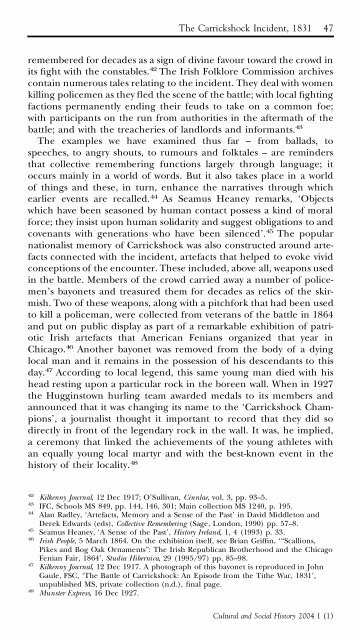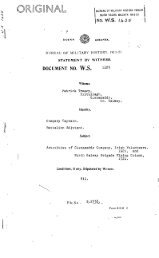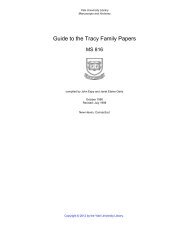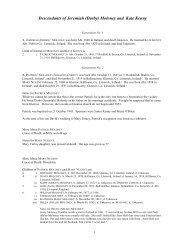The Carrickshock Incident, 1831: Social Memory and an Irish cause ...
The Carrickshock Incident, 1831: Social Memory and an Irish cause ...
The Carrickshock Incident, 1831: Social Memory and an Irish cause ...
Create successful ePaper yourself
Turn your PDF publications into a flip-book with our unique Google optimized e-Paper software.
<strong>The</strong> <strong>Carrickshock</strong> <strong>Incident</strong>, <strong>1831</strong> 47<br />
remembered for decades as a sign of divine favour toward the crowd in<br />
its ght with the constables. 42 <strong>The</strong> <strong>Irish</strong> Folklore Commission archives<br />
contain numerous tales relating to the incident. <strong>The</strong>y deal with women<br />
killing policemen as they ed the scene of the battle; with local ghting<br />
factions perm<strong>an</strong>ently ending their feuds to take on a common foe;<br />
with particip<strong>an</strong>ts on the run from authorities in the aftermath of the<br />
battle; <strong><strong>an</strong>d</strong> with the treacheries of l<strong><strong>an</strong>d</strong>lords <strong><strong>an</strong>d</strong> inform<strong>an</strong>ts. 43<br />
<strong>The</strong> examples we have examined thus far – from ballads, to<br />
speeches, to <strong>an</strong>gry shouts, to rumours <strong><strong>an</strong>d</strong> folktales – are reminders<br />
that collective remembering functions largely through l<strong>an</strong>guage; it<br />
occurs mainly in a world of words. But it also takes place in a world<br />
of things <strong><strong>an</strong>d</strong> these, in turn, enh<strong>an</strong>ce the narratives through which<br />
earlier events are recalled. 44 As Seamus He<strong>an</strong>ey remarks, ‘Objects<br />
which have been seasoned by hum<strong>an</strong> contact possess a kind of moral<br />
force; they insist upon hum<strong>an</strong> solidarity <strong><strong>an</strong>d</strong> suggest obligations to <strong><strong>an</strong>d</strong><br />
coven<strong>an</strong>ts with generations who have been silenced’. 45 <strong>The</strong> popular<br />
nationalist memory of <strong>Carrickshock</strong> was also constructed around artefacts<br />
connected with the incident, artefacts that helped to evoke vivid<br />
conceptions of the encounter. <strong>The</strong>se included, above all, weapons used<br />
in the battle. Members of the crowd carried away a number of policemen’s<br />
bayonets <strong><strong>an</strong>d</strong> treasured them for decades as relics of the skirmish.<br />
Two of these weapons, along with a pitchfork that had been used<br />
to kill a policem<strong>an</strong>, were collected from veter<strong>an</strong>s of the battle in 1864<br />
<strong><strong>an</strong>d</strong> put on public display as part of a remarkable exhibition of patriotic<br />
<strong>Irish</strong> artefacts that Americ<strong>an</strong> Feni<strong>an</strong>s org<strong>an</strong>ized that year in<br />
Chicago. 46 Another bayonet was removed from the body of a dying<br />
local m<strong>an</strong> <strong><strong>an</strong>d</strong> it remains in the possession of his descend<strong>an</strong>ts to this<br />
day. 47 According to local legend, this same young m<strong>an</strong> died with his<br />
head resting upon a particular rock in the boreen wall. When in 1927<br />
the Hugginstown hurling team awarded medals to its members <strong><strong>an</strong>d</strong><br />
<strong>an</strong>nounced that it was ch<strong>an</strong>ging its name to the ‘<strong>Carrickshock</strong> Champions’,<br />
a journalist thought it import<strong>an</strong>t to record that they did so<br />
directly in front of the legendary rock in the wall. It was, he implied,<br />
a ceremony that linked the achievements of the young athletes with<br />
<strong>an</strong> equally young local martyr <strong><strong>an</strong>d</strong> with the best-known event in the<br />
history of their locality. 48<br />
42 Kilkenny Journal, 12 Dec 1917; O’Sulliv<strong>an</strong>, Cinnlae, vol. 3, pp. 93–5.<br />
43 IFC, Schools MS 849, pp. 144, 146, 301; Main collection MS 1240, p. 195.<br />
44 Al<strong>an</strong> Radley, ‘Artefacts, <strong>Memory</strong> <strong><strong>an</strong>d</strong> a Sense of the Past’ in David Middleton <strong><strong>an</strong>d</strong><br />
Derek Edwards (eds), Collective Remembering (Sage, London, 1990) pp. 57–8.<br />
45 Seamus He<strong>an</strong>ey, ‘A Sense of the Past’, History Irel<strong><strong>an</strong>d</strong>, 1, 4 (1993) p. 33.<br />
46 <strong>Irish</strong> People, 5 March 1864. On the exhibition itself, see Bri<strong>an</strong> Grif n, ‘“Scallions,<br />
Pikes <strong><strong>an</strong>d</strong> Bog Oak Ornaments”: <strong>The</strong> <strong>Irish</strong> Republic<strong>an</strong> Brotherhood <strong><strong>an</strong>d</strong> the Chicago<br />
Feni<strong>an</strong> Fair, 1864’, Studia Hibernica, 29 (1995/97) pp. 85–98.<br />
47 Kilkenny Journal, 12 Dec 1917. A photograph of this bayonet is reproduced in John<br />
Gaule, FSC, ‘<strong>The</strong> Battle of <strong>Carrickshock</strong>: An Episode from the Tithe War, <strong>1831</strong>’,<br />
unpublished MS, private collection (n.d.), nal page.<br />
48 Munster Express, 16 Dec 1927.<br />
Cultural <strong><strong>an</strong>d</strong> <strong>Social</strong> History 2004 1 (1)
















